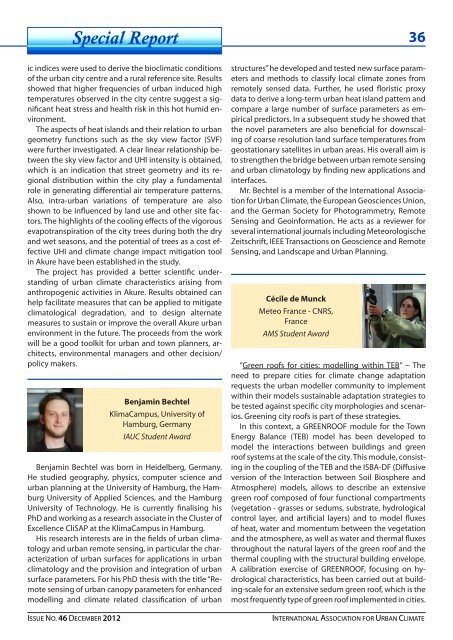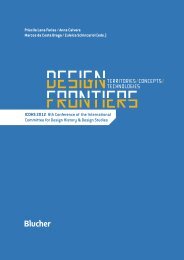Urban Climate News - FAU
Urban Climate News - FAU
Urban Climate News - FAU
Create successful ePaper yourself
Turn your PDF publications into a flip-book with our unique Google optimized e-Paper software.
Special Report<br />
ic indices were used to derive the bioclimatic conditions<br />
of the urban city centre and a rural reference site. Results<br />
showed that higher frequencies of urban induced high<br />
temperatures observed in the city centre suggest a significant<br />
heat stress and health risk in this hot humid environment.<br />
The aspects of heat islands and their relation to urban<br />
geometry functions such as the sky view factor (SVF)<br />
were further investigated. A clear linear relationship between<br />
the sky view factor and UHI intensity is obtained,<br />
which is an indication that street geometry and its regional<br />
distribution within the city play a fundamental<br />
role in generating differential air temperature patterns.<br />
Also, intra-urban variations of temperature are also<br />
shown to be influenced by land use and other site factors.<br />
The highlights of the cooling effects of the vigorous<br />
evapotranspiration of the city trees during both the dry<br />
and wet seasons, and the potential of trees as a cost effective<br />
UHI and climate change impact mitigation tool<br />
in Akure have been established in the study.<br />
The project has provided a better scientific understanding<br />
of urban climate characteristics arising from<br />
anthropogenic activities in Akure. Results obtained can<br />
help facilitate measures that can be applied to mitigate<br />
climatological degradation, and to design alternate<br />
measures to sustain or improve the overall Akure urban<br />
environment in the future. The proceeds from the work<br />
will be a good toolkit for urban and town planners, architects,<br />
environmental managers and other decision/<br />
policy makers.<br />
Benjamin Bechtel<br />
KlimaCampus, University of<br />
Hamburg, Germany<br />
IAUC Student Award<br />
Benjamin Bechtel was born in Heidelberg, Germany.<br />
He studied geography, physics, computer science and<br />
urban planning at the University of Hamburg, the Hamburg<br />
University of Applied Sciences, and the Hamburg<br />
University of Technology. He is currently finalising his<br />
PhD and working as a research associate in the Cluster of<br />
Excellence CliSAP at the KlimaCampus in Hamburg.<br />
His research interests are in the fields of urban climatology<br />
and urban remote sensing, in particular the characterization<br />
of urban surfaces for applications in urban<br />
climatology and the provision and integration of urban<br />
surface parameters. For his PhD thesis with the title “Remote<br />
sensing of urban canopy parameters for enhanced<br />
modelling and climate related classification of urban<br />
ISSUE NO. 46 DECEMBER 2012 INTERNATIONAL ASSOCIATION FOR URBAN CLIMATE<br />
3<br />
structures” he developed and tested new surface parameters<br />
and methods to classify local climate zones from<br />
remotely sensed data. Further, he used floristic proxy<br />
data to derive a long-term urban heat island pattern and<br />
compare a large number of surface parameters as empirical<br />
predictors. In a subsequent study he showed that<br />
the novel parameters are also beneficial for downscaling<br />
of coarse resolution land surface temperatures from<br />
geostationary satellites in urban areas. His overall aim is<br />
to strengthen the bridge between urban remote sensing<br />
and urban climatology by finding new applications and<br />
interfaces.<br />
Mr. Bechtel is a member of the International Association<br />
for <strong>Urban</strong> <strong>Climate</strong>, the European Geosciences Union,<br />
and the German Society for Photogrammetry, Remote<br />
Sensing and Geoinformation. He acts as a reviewer for<br />
several international journals including Meteorologische<br />
Zeitschrift, IEEE Transactions on Geoscience and Remote<br />
Sensing, and Landscape and <strong>Urban</strong> Planning.<br />
Cécile de Munck<br />
Meteo France - CNRS,<br />
France<br />
AMS Student Award<br />
“Green roofs for cities: modelling within TEB” − The<br />
need to prepare cities for climate change adaptation<br />
requests the urban modeller community to implement<br />
within their models sustainable adaptation strategies to<br />
be tested against specific city morphologies and scenarios.<br />
Greening city roofs is part of these strategies.<br />
In this context, a GREENROOF module for the Town<br />
Energy Balance (TEB) model has been developed to<br />
model the interactions between buildings and green<br />
roof systems at the scale of the city. This module, consisting<br />
in the coupling of the TEB and the ISBA-DF (Diffusive<br />
version of the Interaction between Soil Biosphere and<br />
Atmosphere) models, allows to describe an extensive<br />
green roof composed of four functional compartments<br />
(vegetation - grasses or sedums, substrate, hydrological<br />
control layer, and artificial layers) and to model fluxes<br />
of heat, water and momentum between the vegetation<br />
and the atmosphere, as well as water and thermal fluxes<br />
throughout the natural layers of the green roof and the<br />
thermal coupling with the structural building envelope.<br />
A calibration exercise of GREENROOF, focusing on hydrological<br />
characteristics, has been carried out at building-scale<br />
for an extensive sedum green roof, which is the<br />
most frequently type of green roof implemented in cities.
















